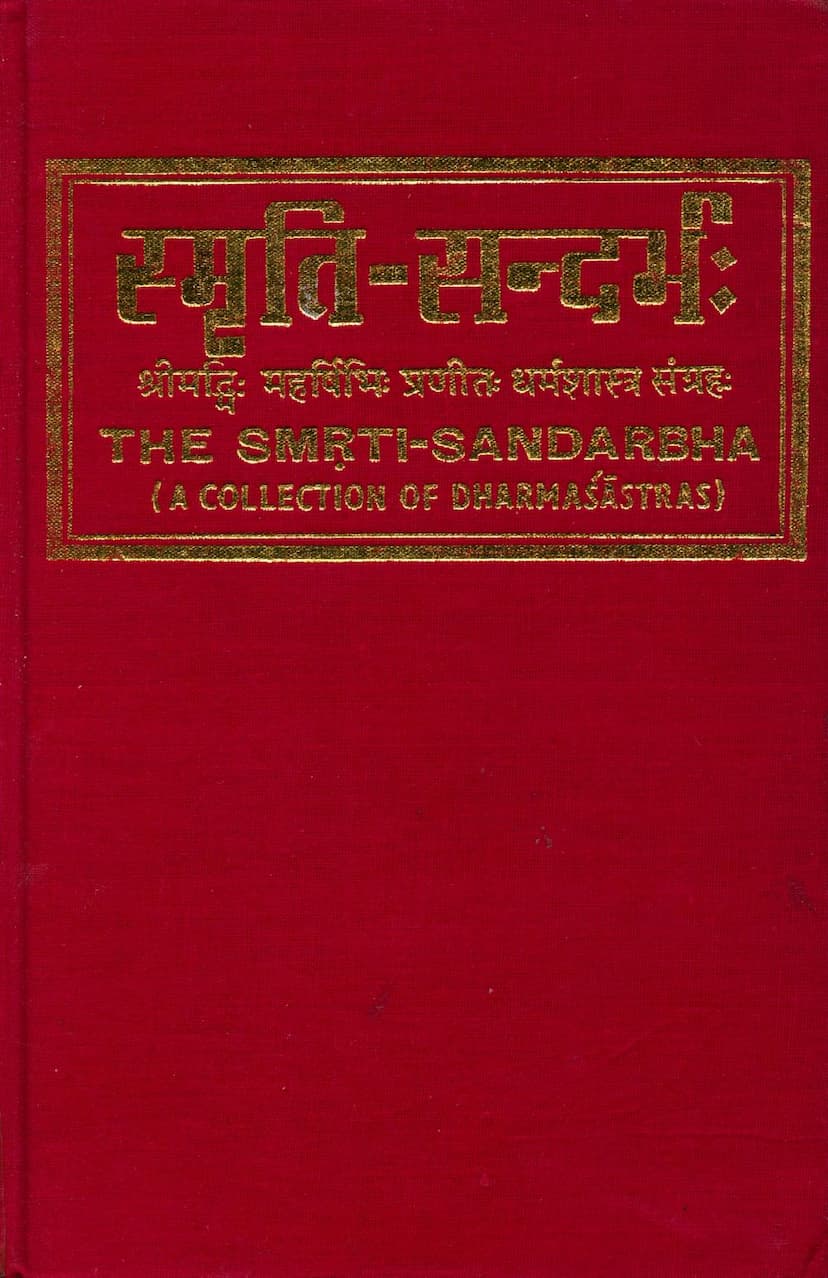Smruti Sandarbh Part 06
Added to library: September 2, 2025

Summary
Based on the provided table of contents (सूचीपत्रम्) from "Smruti Sandarbh Part 06" by Maharshi, which contains the Markandeya Smriti and Laugakshi Smriti, here's a comprehensive summary in English:
This volume, the sixth part of the "Smruti Sandarbha" collection, is a compilation of two significant Dharmashastric texts: the Markandeya Smriti and the Laugakshi Smriti, attributed to Maharshis Markandeya and Laugakshi respectively. Published with financial assistance from the Ministry of Human Resource Development, Government of India, this revised and expanded edition from 1988 provides a detailed exploration of Jain religious and ethical principles as outlined in these ancient texts.
The Markandeya Smriti, as detailed in the table of contents, covers a vast array of topics crucial for righteous living and spiritual progression. The primary themes include:
- Varnashrama Dharma: The duties and conduct associated with the different social orders (Varnas) and stages of life (Ashramas).
- Brahmacharya Dharma: The discipline and rules for studentship, including Vedic study, begging for alms, and conduct towards the Guru.
- Grahstha Dharma: The merits and responsibilities of householders, emphasizing the importance of this ashrama.
- Pratyashchitta (Atonement): Extensive discussions on expiation for various sins and transgressions, detailing specific rituals and penances. This includes the atonement for Avakīrṇi Brahmachari, a student who has broken vows.
- Yajnas (Sacrifices): Descriptions of twenty-one types of Yajnas and their significance.
- Daan (Charity/Giving): A significant portion is dedicated to the praise of charity, its recipients and non-recipients, the fruits of giving, types of valuable items for donation, and specific great charities like gifting land, gold, and daughters (Kanyadan).
- Shraddha (Ancestor Worship): Detailed procedures for performing Shraddha rituals, including different types like Mahalaya Shraddha, Gaya Shraddha, and the significance of performing them for ancestors.
- Purity and Rituals: Descriptions of purification methods, including bathing (Snana), chanting mantras like Gayatri, performing Sandhya rituals, and rules for eating and daily conduct.
- Purity of Speech and Thought: Emphasis on the importance of Sanskrit, the virtue of silence (Mauna), and the condemnation of false religious practices.
- Vedic Studies: The importance of Vedic learning, the rules for its transmission, and the consequences of neglecting it. It also discusses the concept of "Punarvedadhikara" for those who had previously abandoned Vedic study.
- Social Customs and Etiquette: Rules regarding behavior, especially for children, marriage customs, and the importance of auspicious actions and their interpretations.
- Prohibitions and Cautions: Discussions on forbidden actions, foods (Abhakshya), and the dire consequences of violating Dharma.
- The Significance of Brahmins: The paramount importance and greatness of Brahmins, their role in purification and spiritual guidance.
- Purity of Actions and Intentions: The text stresses that actions must be performed with the right intention and devotion.
- Fasting and Penance: Various types of fasts and austerities (Krichra) are mentioned as means of purification.
- Dharmasastra Interpretation: Guidance on reconciling and understanding the various Dharmashastras and their application in different contexts.
The Laugakshi Smriti, complementing the Markandeya Smriti, focuses on:
- Samskaras: The rites of passage, starting from Jatakarma (birth rituals) and Namakarana (naming ceremony) to Upanayana (initiation) and marriage.
- Brahmacharya and Vrata: The student's life and the vows they undertake.
- Daily Rituals: Emphasis on daily observances like Sandhya, Agnihotra, and Brahmayajna.
- Marriage and Family Life: Guidelines related to marriage, the importance of progeny, and the duties of individuals within the family structure.
- Purity and Auspiciousness: The significance of observing purity, auspicious times, and the interpretation of omens, including bird omens and their implications.
- Prohibitions and Auspiciousness: Rules about forbidden actions, the importance of auspicious beginnings, and the interpretation of various signs and symbols.
- Spiritual Practices: The role of prayer, chanting, and devotion in achieving spiritual merit.
- Yogic Practices: Mention of Pranayama and its importance in controlling breath and purifying the mind.
- The Significance of Gayatri: The central role and power of the Gayatri mantra are highlighted.
- The Importance of Brahmins: Continuing the theme from Markandeya Smriti, Laugakshi also emphasizes the reverence due to Brahmins.
- Purity and Conduct: Detailed discussions on external and internal purity, dental hygiene, and the proper way to perform various rituals.
- The Importance of Divine Names: The text highlights the efficacy of remembering and chanting the names of deities.
- The Vedas and Their Importance: The Vedas are presented as the ultimate source of knowledge and the path to liberation.
Overall, this volume provides a comprehensive guide to the duties, rituals, and ethical principles that form the foundation of a righteous life according to ancient Jain tradition, as expounded by these revered Maharshis. It covers a wide spectrum of life, from birth to death, and emphasizes the importance of purity, devotion, righteous conduct, and adherence to scriptural injunctions.